Euan G. Mason (born c.1953 ^ ) [1] is a Professor at the School of Forestry in the University of Canterbury in Christchurch, New Zealand.
Euan G. Mason (born c.1953 ^ ) [1] is a Professor at the School of Forestry in the University of Canterbury in Christchurch, New Zealand.
Mason was born in Invercargill, New Zealand but raised in Lower Hutt and Geneva before moving on to New Jersey. His hobbies include astronomy, music, computer programming and football. [2] Mason completed a PhD at the University of Canterbury in 1992. [3]
His main research areas include silviculture, growth and yield modelling, hybrid modelling and decision-support (applied artificial intelligence). [4] He is skilled in the field of dendrology, the identification of tree species. He was editor of the New Zealand Journal of Forestry from 2006.

Conifers are a group of cone-bearing seed plants, a subset of gymnosperms. Scientifically, they make up the division Pinophyta, also known as Coniferophyta or Coniferae. The division contains a single extant class, Pinopsida. All extant conifers are perennial woody plants with secondary growth. The great majority are trees, though a few are shrubs. Examples include cedars, Douglas-firs, cypresses, firs, junipers, kauri, larches, pines, hemlocks, redwoods, spruces, and yews. As of 2002, Pinophyta contained seven families, 60 to 65 genera, and more than 600 living species.

Pinus radiata, the Monterey pine, insignis pine or radiata pine, is a species of pine native to the Central Coast of California and Mexico. It is an evergreen conifer in the family Pinaceae.
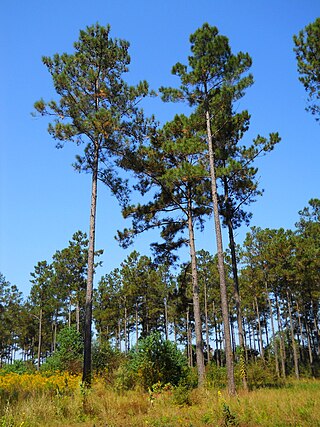
Pinus taeda, commonly known as loblolly pine, is one of several pines native to the Southeastern United States, from East Texas to Florida, and north to southern New Jersey. The wood industry classifies the species as a southern yellow pine. U.S. Forest Service surveys found that loblolly pine is the second-most common species of tree in the United States, after red maple. For its timber, the pine species is regarded as the most commercially important tree in the Southeastern U.S. The common name loblolly is given because the pine species is found mostly in lowlands and swampy areas.
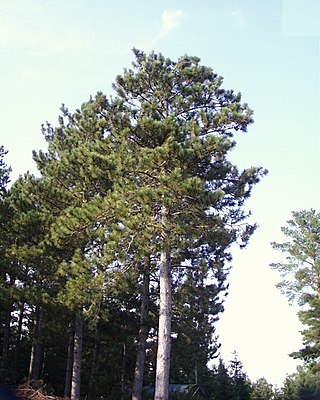
Pinus resinosa, known as red pine, is a pine native to North America.

Pinus elliottii, commonly known as slash pine, is a conifer tree native to the Southeastern United States. Slash pine is named after the "slashes" – swampy ground overgrown with trees and bushes – that constitute its habitat. Other common names include swamp pine, yellow slash pine, and southern Florida pine. Slash pine has two different varieties: P. e. var. elliottii and P. e. var. densa. Historically, slash pine has been an important economic timber for naval stores, turpentine, and resin. The wood of slash pine is known for its unusually high strength, especially for a pine. It exceeds many hardwoods and is even comparable to very dense woods such as ironwood.
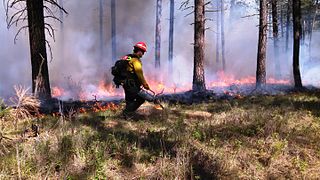
A controlled or prescribed (Rx) burn, which can include hazard reduction burning, backfire, swailing or a burn-off, is a fire set intentionally for purposes of forest management, fire suppression, farming, prairie restoration or greenhouse gas abatement. A controlled burn may also refer to the intentional burning of slash and fuels through burn piles. Fire is a natural part of both forest and grassland ecology and controlled fire can be a tool for foresters.

The Lone Pine was a solitary tree on the Gallipoli Peninsula in Turkey, which marked the site of the Battle of Lone Pine in August 1915. It was a Turkish or East Mediterranean pine.

Rhizopogon is a genus of ectomycorrhizal basidiomycetes in the family Rhizopogonaceae. Species form hypogeous sporocarps commonly referred to as "false truffles". The general morphological characters of Rhizopogon sporocarps are a simplex or duplex peridium surrounding a loculate gleba that lacks a columnella. Basidiospores are produced upon basidia that are borne within the fungal hymenium that coats the interior surface of gleba locules. The peridium is often adorned with thick mycelial cords, also known as rhizomorphs, that attach the sporocarp to the surrounding substrate. The scientific name Rhizopogon is Greek for 'root' (Rhiz-) 'beard' (-pogon) and this name was given in reference to the rhizomorphs found on sporocarps of many species.
The New Zealand Journal of Forestry is the journal of the New Zealand Institute of Forestry. It publishes articles on a wide range of forestry-related topics, primarily on issues that are relevant to New Zealand and the South Pacific region. The published articles include peer reviewed scientific research papers, items of current interest, opinion pieces and book reviews. It is currently edited by Chris Goulding.

Wilding conifers, also known as wilding pines, are invasive trees in the high country of New Zealand. Millions of dollars are spent on controlling their spread.

Woodchipping in New Zealand is one of the sectors of the forestry industry and it attracted controversy in the 1990s when native trees were used as a source for the chipping.

Suillus brevipes is a species of fungus in the family Suillaceae. First described by American mycologists in the late 19th century, it is commonly known as the stubby-stalk or the short-stemmed slippery Jack. The fruit bodies (mushrooms) produced by the fungus are characterized by a chocolate to reddish-brown cap covered with a sticky layer of slime, and a short whitish stipe that has neither a partial veil nor prominent, colored glandular dots. The cap can reach a diameter of about 10 cm, while the stipe is up to 6 cm long and 2 cm thick. Like other bolete mushrooms, S. brevipes produces spores in a vertically arranged layer of spongy tubes with openings that form a layer of small yellowish pores on the underside of the cap.

Forestry in New Zealand has a history starting with European settlement in the 19th century and is now an industry worth seven percent of annual revenue. Much of the original native forest cover was burnt off and logged, however forests have been extensively planted, predominantly with fast-growing cultivars of the Monterey Pine. Wood chips, whole logs, lumber and paper products are exported from New Zealand.

Fusarium circinatum is a fungal plant pathogen that causes the serious disease pitch canker on pine trees and Douglas firs. The most common hosts of the pathogen include slash pine, loblolly pine, Monterey pine, Mexican weeping pine, and Douglas fir. Like other Fusarium species in the phylum Ascomycota, it is the asexual reproductive state of the fungus and has a teleomorph, Gibberella circinata.

Hylastes ater is a species of beetle in the family Curculionidae, the true weevils. It is a bark beetle, a member of the subfamily Scolytinae. Its common name is the black pine bark beetle. It is native to Europe and parts of Asia, including China and Korea. It is known as an introduced species in many other regions, including Australia, New Zealand, the Americas, and South Africa. It is a pest of pines and other trees, and it is widespread in areas where pine trees are cultivated. The species "is an important threat to the biosecurity of all forested countries."
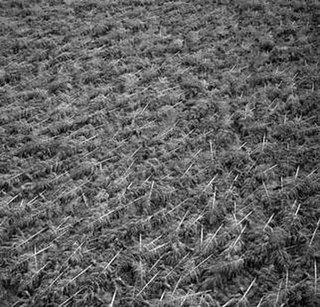
Eyrewell Forest is a small rural area in the Waimakariri District, New Zealand.
Phytophthora pluvialis is a semi-papillate plant pathogen that mainly infects tanoak-Douglas-fir forests of western Oregon. It was reported in Cornwall. UK, in October 2021; the first record for Europe.
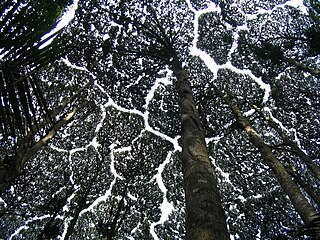
Crown shyness is a feature observed in some tree species, in which the crowns of fully stocked trees do not touch each other, instead forming a canopy with channel-like gaps. This is most prevalent among trees of the same species, but also occurs between trees of different species. There exist many hypotheses as to why crown shyness is an adaptive behavior, and research suggests that it might inhibit spread of leaf-eating insect larvae.
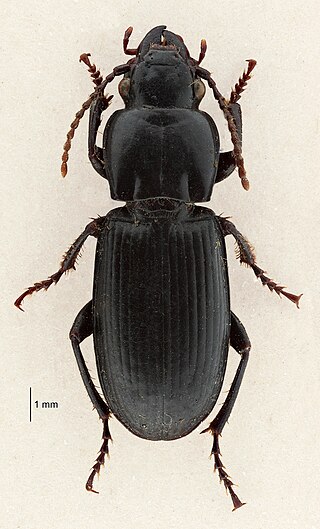
Holcaspis brevicula, the Eyrewell ground beetle, is a species of carabid beetle native to New Zealand, one of a number of small black flightless beetles in the genus Holcaspis that inhabit the dry eastern lowlands of the South Island. H. brevicula is very rare—only ten specimens have ever been collected—and critically endangered: the species was found only in Eyrewell Forest, a single plantation of exotic pine trees currently being converted into dairy farms.
Diana F. Tomback is an American ecologist and an academic. She is a professor of Integrative Biology at the University of Colorado Denver as well as the policy and outreach coordinator at the Whitebark Pine Ecosystem Foundation, a non-profit organization.